Case Studies of Waste-to-Energy Projects
Added on 2023-06-05
24 Pages6416 Words426 Views
Running head: BUSINESS RESEARCH METHODOLOGY
Case studies of WTE projects
Name of the student
Name of the university
Author Note:
Case studies of WTE projects
Name of the student
Name of the university
Author Note:
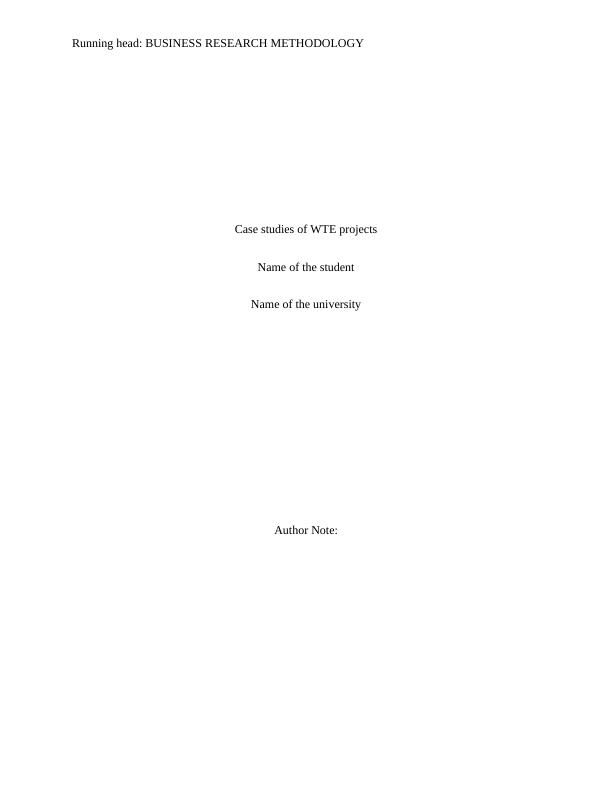
2
BUSINESS RESEARCH METHODOLOGY
Table of Contents
Introduction......................................................................................................................................4
Background......................................................................................................................................4
Case studies.....................................................................................................................................5
1st Case Study...............................................................................................................................5
Part 1: Development of WTE Industry in China.........................................................................5
Introduction..................................................................................................................................5
Technologies used for Sustainable Waste Management System.................................................6
Generation of Municipal Solid Waste in China...........................................................................7
Municipal Solid Waste Treatment in China................................................................................7
Recycling.....................................................................................................................................8
Waste to Energy...........................................................................................................................9
Composting................................................................................................................................10
Land filling................................................................................................................................10
Non Regulated Land-Filling......................................................................................................10
Disposition of Municipal Solid Wastes in different cities and provinces.................................11
Status of WTE industry in China and Technology used............................................................11
Challenges faced in the construction of WTE building.............................................................12
Laws and Regulations on Municipal Solid Wastes...................................................................13
BUSINESS RESEARCH METHODOLOGY
Table of Contents
Introduction......................................................................................................................................4
Background......................................................................................................................................4
Case studies.....................................................................................................................................5
1st Case Study...............................................................................................................................5
Part 1: Development of WTE Industry in China.........................................................................5
Introduction..................................................................................................................................5
Technologies used for Sustainable Waste Management System.................................................6
Generation of Municipal Solid Waste in China...........................................................................7
Municipal Solid Waste Treatment in China................................................................................7
Recycling.....................................................................................................................................8
Waste to Energy...........................................................................................................................9
Composting................................................................................................................................10
Land filling................................................................................................................................10
Non Regulated Land-Filling......................................................................................................10
Disposition of Municipal Solid Wastes in different cities and provinces.................................11
Status of WTE industry in China and Technology used............................................................11
Challenges faced in the construction of WTE building.............................................................12
Laws and Regulations on Municipal Solid Wastes...................................................................13

3
BUSINESS RESEARCH METHODOLOGY
PESTLE Analysis of WTE in China.........................................................................................14
2nd Case Study................................................................................................................................15
Introduction................................................................................................................................15
Anaerobic Digestion and its working style................................................................................16
Anaerobic Digestion Plant Monitoring......................................................................................17
Bioelectric Company.................................................................................................................17
General AD Plant description....................................................................................................18
Biogas Plant Mureck (Austria)..................................................................................................18
General Description...................................................................................................................18
Outcomes of the different Monitoring in Mureck (Austria)......................................................19
PESTLE Analysis of AD plants in Austria................................................................................19
Comparison between the two Case Studies...............................................................................20
Conclusion.....................................................................................................................................21
References......................................................................................................................................22
BUSINESS RESEARCH METHODOLOGY
PESTLE Analysis of WTE in China.........................................................................................14
2nd Case Study................................................................................................................................15
Introduction................................................................................................................................15
Anaerobic Digestion and its working style................................................................................16
Anaerobic Digestion Plant Monitoring......................................................................................17
Bioelectric Company.................................................................................................................17
General AD Plant description....................................................................................................18
Biogas Plant Mureck (Austria)..................................................................................................18
General Description...................................................................................................................18
Outcomes of the different Monitoring in Mureck (Austria)......................................................19
PESTLE Analysis of AD plants in Austria................................................................................19
Comparison between the two Case Studies...............................................................................20
Conclusion.....................................................................................................................................21
References......................................................................................................................................22
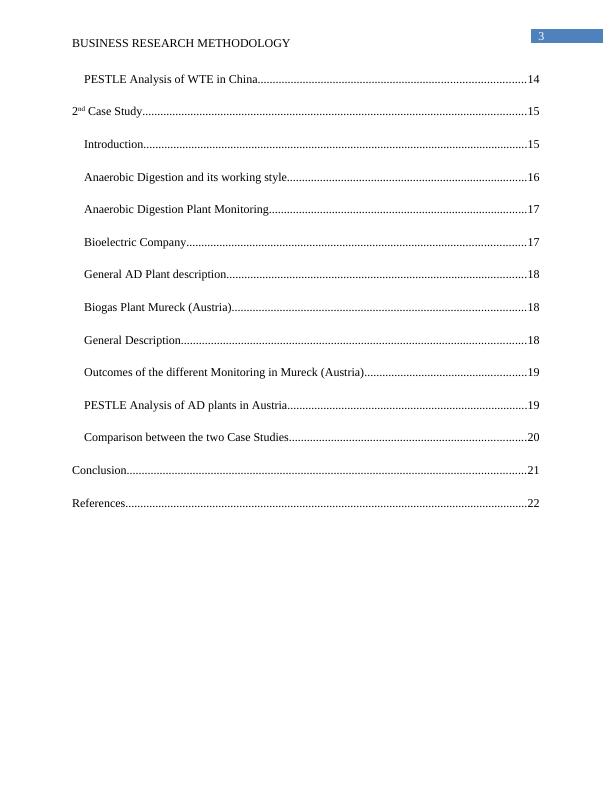
4
BUSINESS RESEARCH METHODOLOGY
Introduction
Globalization has led to a number of different impacts both positive as well as negative in
the world. The negative impacts of globalization are seen to be much more in than the positive
impacts. One of the main such source of negative impact is the municipal solid waste which is
often referred to as garbage. This garbage is often dumped in dumped yards from where the
pollution and other different health issues arise. Such kinds of problems must be removed
accordingly to ensure the presence of a safe and hygienic environment. The following
assignment has dealt with the conversion of such kind of wastes to energy which helps to reduce
the pollution and make the globe a better place for the humans for residing (Bossink 2017). The
report has been prepared on the basis of two different case studies on the same topic. The first
case study has been selected from an example in China while the second case study has been
selected from the case of anaerobic digestion plants and their use in Austria to produce Bio-
Methane gas that can act as a substitute to petrol and diesel in the future.
Background
Waste to energy conversion is a scientific process where the solid wastes of the urban
area are converted to electricity or bio chemical gases that can act as fuel and contribute in the
cleanup of the globe. The main reason to burn the municipal Solid Waste is however believed to
be producing electricity. The burning of the waste in a controlled and scientific manner also
helps to reduce the amount of material or wastes generated during the burning of the same waste
in the landfills or the dump yards. The disposal and the proper generation of the solid wastes
possess a great challenge to the authority of the different countries to ensure hygiene and natural
sustainability. The more is the absence of a scientific disposal system in the cities, the more will
BUSINESS RESEARCH METHODOLOGY
Introduction
Globalization has led to a number of different impacts both positive as well as negative in
the world. The negative impacts of globalization are seen to be much more in than the positive
impacts. One of the main such source of negative impact is the municipal solid waste which is
often referred to as garbage. This garbage is often dumped in dumped yards from where the
pollution and other different health issues arise. Such kinds of problems must be removed
accordingly to ensure the presence of a safe and hygienic environment. The following
assignment has dealt with the conversion of such kind of wastes to energy which helps to reduce
the pollution and make the globe a better place for the humans for residing (Bossink 2017). The
report has been prepared on the basis of two different case studies on the same topic. The first
case study has been selected from an example in China while the second case study has been
selected from the case of anaerobic digestion plants and their use in Austria to produce Bio-
Methane gas that can act as a substitute to petrol and diesel in the future.
Background
Waste to energy conversion is a scientific process where the solid wastes of the urban
area are converted to electricity or bio chemical gases that can act as fuel and contribute in the
cleanup of the globe. The main reason to burn the municipal Solid Waste is however believed to
be producing electricity. The burning of the waste in a controlled and scientific manner also
helps to reduce the amount of material or wastes generated during the burning of the same waste
in the landfills or the dump yards. The disposal and the proper generation of the solid wastes
possess a great challenge to the authority of the different countries to ensure hygiene and natural
sustainability. The more is the absence of a scientific disposal system in the cities, the more will
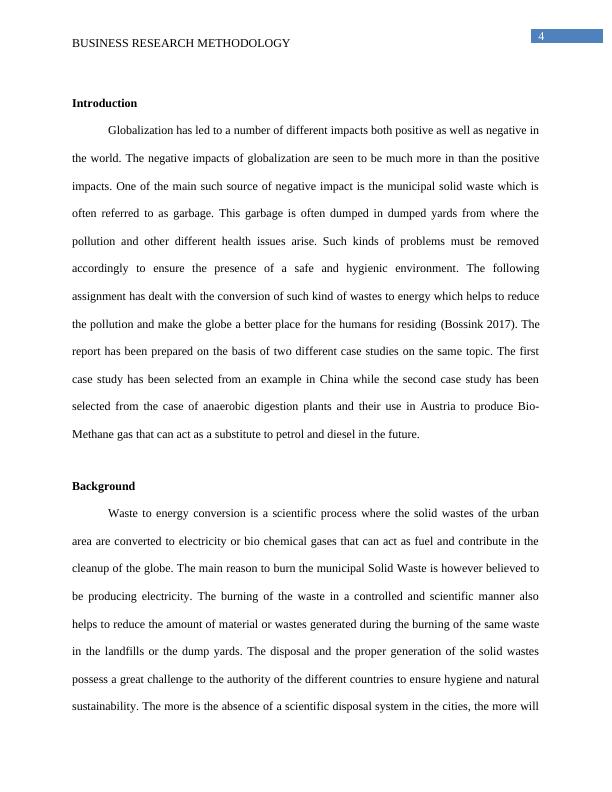
5
BUSINESS RESEARCH METHODOLOGY
be the problem in their control. There is a high need for intelligent waste management system as
the presence of a structured and organized waste management system helps in the development
of the creation of a smart and technologically and hygienically advanced city. The following
parts of the assignment will discuss and analyze the different elements related to the elements of
the case study on the conversion of wastes to energy in Austria and China.
Case studies
1st Case Study
“Development of Waste‐To‐Energy in China; and Case Study of the Guangzhou Likeng WTE
plant”
Part 1: Development of WTE Industry in China
Introduction
The growth of China in the last few years have been the most enhancing as it has been
able to capture the attention of the world. The change in the mindset of the Government to
gradually make the country a manufacturing hub from that of an agricultural based economy.
The country was able to woo the western as well as the local manufacturers as they promoted
themselves as the ideal hub for the manufacture of different goods and services. The ideal
strategies, the use of aggressive marketing policies was enough to change the minds o0f the
companies and soon the country became the largest manufacturing hub of the globe
(ea-stmk.at/documents 2018). The rapid economic growth, economic growth and the
urbanization have helped the cause of the country. However such rapid developments also saw
the huge rise in the creation and collection of solid waste that was beyond the expectation of
other countries in Asia as well as the other countries of the globe. The generation and disposal of
BUSINESS RESEARCH METHODOLOGY
be the problem in their control. There is a high need for intelligent waste management system as
the presence of a structured and organized waste management system helps in the development
of the creation of a smart and technologically and hygienically advanced city. The following
parts of the assignment will discuss and analyze the different elements related to the elements of
the case study on the conversion of wastes to energy in Austria and China.
Case studies
1st Case Study
“Development of Waste‐To‐Energy in China; and Case Study of the Guangzhou Likeng WTE
plant”
Part 1: Development of WTE Industry in China
Introduction
The growth of China in the last few years have been the most enhancing as it has been
able to capture the attention of the world. The change in the mindset of the Government to
gradually make the country a manufacturing hub from that of an agricultural based economy.
The country was able to woo the western as well as the local manufacturers as they promoted
themselves as the ideal hub for the manufacture of different goods and services. The ideal
strategies, the use of aggressive marketing policies was enough to change the minds o0f the
companies and soon the country became the largest manufacturing hub of the globe
(ea-stmk.at/documents 2018). The rapid economic growth, economic growth and the
urbanization have helped the cause of the country. However such rapid developments also saw
the huge rise in the creation and collection of solid waste that was beyond the expectation of
other countries in Asia as well as the other countries of the globe. The generation and disposal of
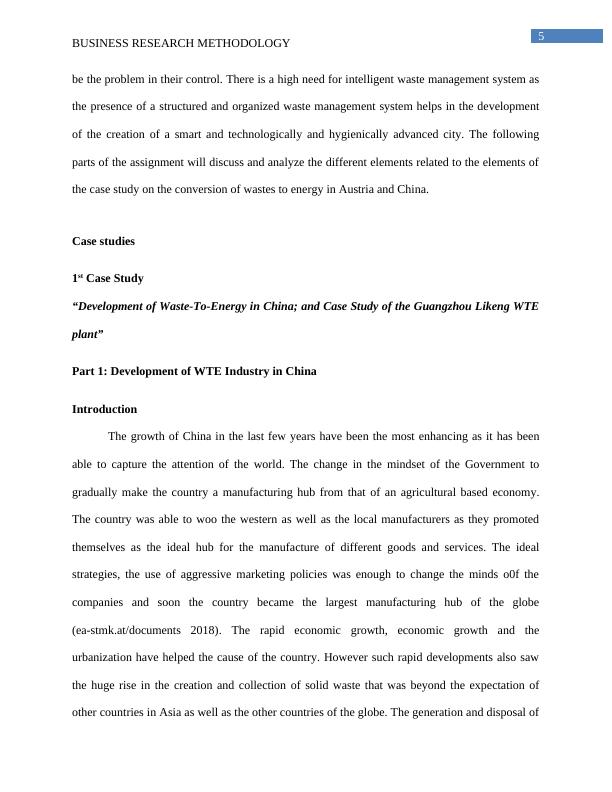
6
BUSINESS RESEARCH METHODOLOGY
the municipal solid wastes thus pose a huge challenge for the Government of the country to
participate in other developmental processes. The increase in the areas of large cities like
Beijing, Shanghai, Guangzhou and Shandong have been posing significant amount of risks and
threat to the country as there is an urgent need for a solid waste management program in these
cities to ensure the proper disposal of these wastes. The more easy and scientific is the solid
waste management system, the more is the chance for the further development of the country.
Technologies used for Sustainable Waste Management System
The authorities especially the municipal development authorities in these particular cities
have their basic priority to reduce the amount of wastes generated by means of a better deigning
and a better packaging of the products of the company. The recyclable products are generally
segregated into five different categories according to their different characteristics. This includes
the likes of the;
a. Fabric includes clothing, linen, towels and many more as such
b. Plastics such as plastic bags, plastic cans, plastic cups, plastic wastes
c. Glass bottles, glass boxes, glass mirrors
d. Papers like newspapers, books, copies, documents, office papers and many more similar
to them
e. Metal boxes, junk metals, cans, rods etc
There are nations like Japan and some European nations where the government aims to fulfill
the target of Zero waste. The next step is ensuring the composition of the wastes and converting
them to carbon-di-oxide aerobically and an aerobically to methane which can act as fuels and
other useful products (Ferdan et al. 2015). After the completion of the following steps, the task
BUSINESS RESEARCH METHODOLOGY
the municipal solid wastes thus pose a huge challenge for the Government of the country to
participate in other developmental processes. The increase in the areas of large cities like
Beijing, Shanghai, Guangzhou and Shandong have been posing significant amount of risks and
threat to the country as there is an urgent need for a solid waste management program in these
cities to ensure the proper disposal of these wastes. The more easy and scientific is the solid
waste management system, the more is the chance for the further development of the country.
Technologies used for Sustainable Waste Management System
The authorities especially the municipal development authorities in these particular cities
have their basic priority to reduce the amount of wastes generated by means of a better deigning
and a better packaging of the products of the company. The recyclable products are generally
segregated into five different categories according to their different characteristics. This includes
the likes of the;
a. Fabric includes clothing, linen, towels and many more as such
b. Plastics such as plastic bags, plastic cans, plastic cups, plastic wastes
c. Glass bottles, glass boxes, glass mirrors
d. Papers like newspapers, books, copies, documents, office papers and many more similar
to them
e. Metal boxes, junk metals, cans, rods etc
There are nations like Japan and some European nations where the government aims to fulfill
the target of Zero waste. The next step is ensuring the composition of the wastes and converting
them to carbon-di-oxide aerobically and an aerobically to methane which can act as fuels and
other useful products (Ferdan et al. 2015). After the completion of the following steps, the task
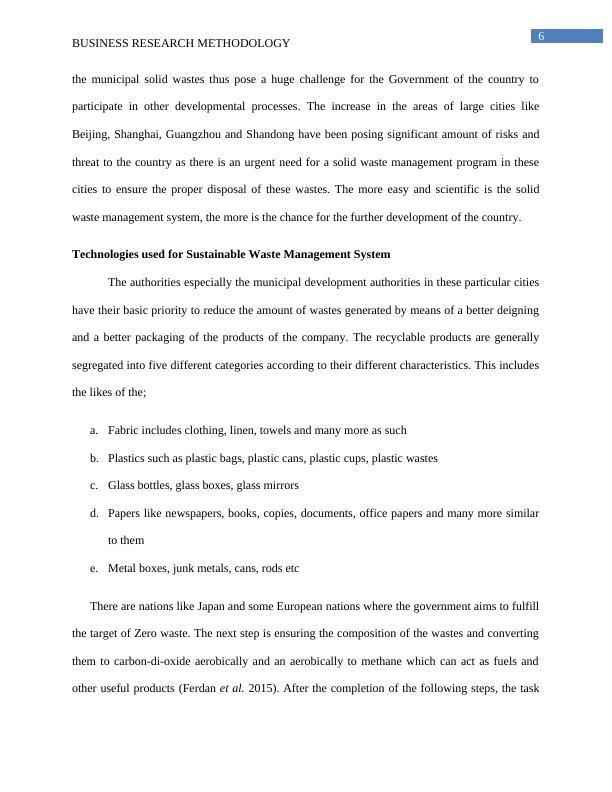
End of preview
Want to access all the pages? Upload your documents or become a member.
